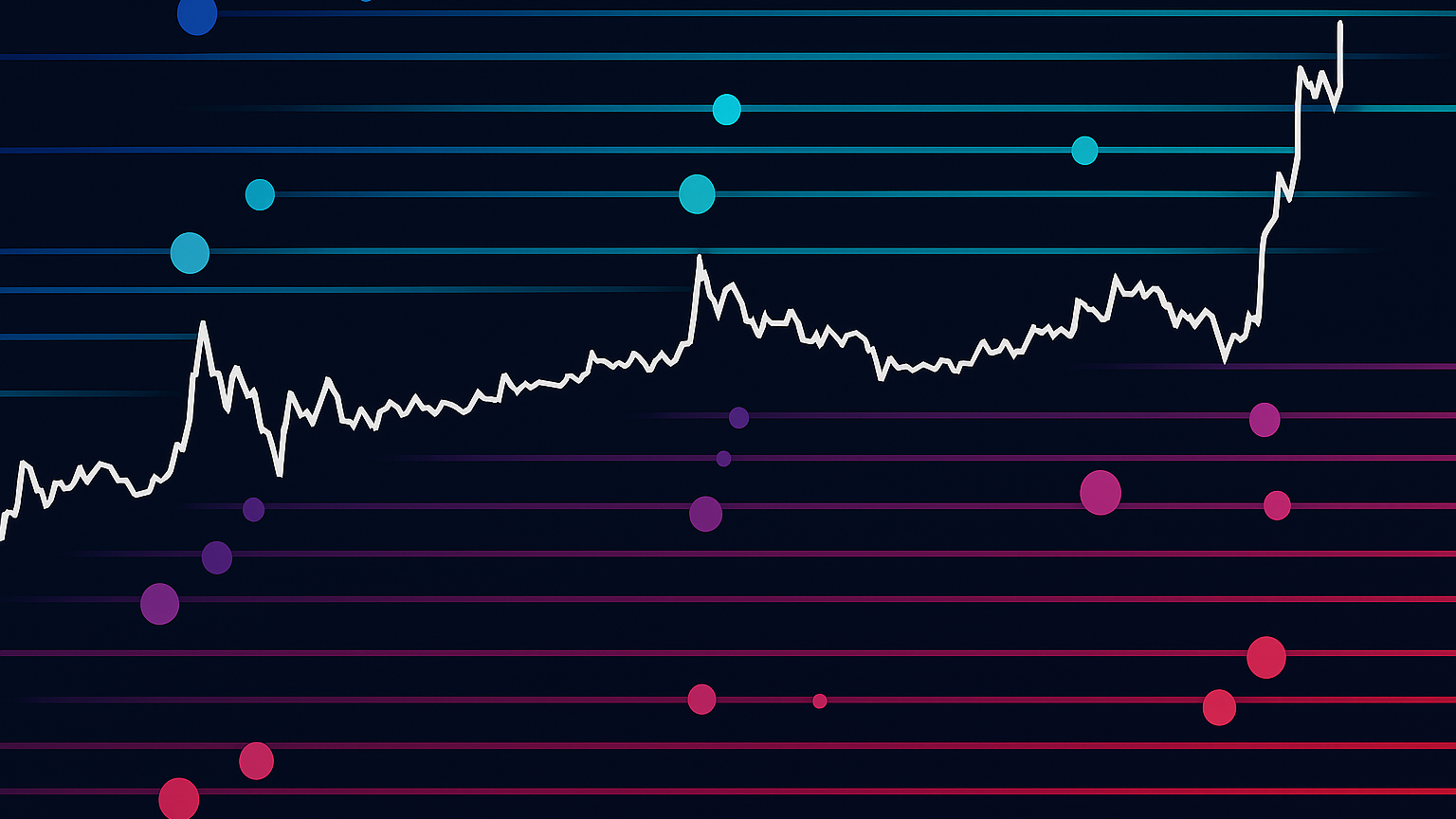Understand key trading indicators like overlays and oscillators to improve your trading strategies and decision-making.
Trading indicators simplify decision-making by turning market data into actionable insights. They help traders identify trends, measure momentum, and time their trades effectively. Here’s a quick breakdown:
- Overlays like Moving Averages (MAs) and Bollinger Bands track price trends and volatility directly on charts.
- Oscillators like RSI and MACD measure momentum and identify overbought/oversold conditions.
- Combining indicators, such as using MAs for trends and RSI for momentum, improves accuracy.
To get started:
- Use tools like RSI (default 14-period) to spot reversals.
- Pair trend-following indicators (MAs) with momentum tools (MACD).
- Backtest strategies and adjust settings based on market conditions.
Avoid relying on one indicator alone and always consider the broader market context. LuxAlgo's exclusive indicators can streamline analysis using more detailed toolkit indicators and help traders optimize strategies through AI-driven insights.
Common Types of Trading Indicators
Trading indicators are typically grouped into two categories: overlays and oscillators. Knowing how they work can help traders choose the right tools for their strategies.
Overlays: Indicators Placed on Price Charts
Overlays are displayed directly on price charts to help analyze price movements, trends, and key levels.
For example, Moving Averages (MAs) and Bollinger Bands are widely used overlays. Moving Averages smooth out price fluctuations, making trends easier to spot. A popular signal is the "golden cross", which occurs when a shorter-term MA (like the 50-day) crosses above a longer-term MA (like the 200-day) [2].
| Overlay Type | Primary Function | Key Signals |
|---|---|---|
| Simple Moving Average (SMA) | Tracks trend direction | Crossovers, Support/Resistance |
| Exponential Moving Average (EMA) | Highlights price momentum | Trend Reversals, Dynamic Support |
| Bollinger Bands | Measures volatility | Price Breakouts, Mean Reversion |
Oscillators: Indicators That Move Within a Range
Oscillators are tools that fluctuate between fixed values, usually between 0 and 100, to help spot potential trend reversals. They're especially useful in markets that lack clear direction.
The Relative Strength Index (RSI) is a popular oscillator that identifies overbought or oversold conditions. Typically, RSI readings above 70 suggest overbought conditions, while readings below 30 indicate oversold levels [4]. However, in trending markets, these levels may stay elevated or suppressed, requiring more nuanced interpretation [5].
Another widely used oscillator is the Moving Average Convergence Divergence (MACD). It combines trend-following and momentum analysis by comparing two moving averages. MACD signals are generated through line crossovers, centerline crossings, and divergences [6].
It's important to note that no single indicator is flawless. Combining different types of indicators can improve analysis, but avoid using tools that provide overlapping signals [1][7].
With this understanding of overlays and oscillators, we can dive into how traders apply these tools and address common questions.
FAQs About Trading Indicators
Let’s address some common questions about using trading indicators effectively, building on the basics of overlays and oscillators.
What Are the Most Common Indicators and How Are They Used?
Popular trading indicators serve different roles in technical analysis. For example, the Moving Average Convergence Divergence (MACD) is used to identify trends and momentum shifts. MACD crossovers can indicate potential buy signals (when above the signal line) or sell signals (when below the signal line) [1].
The Relative Strength Index (RSI) is particularly useful for spotting possible market reversals. Oanda highlights this by saying:
"The RSI's simplicity stems from its clear and concise signals, as well as its ease of interpretation" [5].
| Indicator | Primary Use | Key Signals |
|---|---|---|
| RSI | Reversals | Overbought (>70), Oversold (<30) |
| MACD | Trend/Momentum | Buy/Sell Crossovers |
| Stochastic | Price Momentum | Above 80 / Below 20 |
How Can I Combine Indicators Effectively?
To use indicators together, pair tools with complementary purposes, such as trend-following and momentum-based tools. Here’s a practical method:
- Use Moving Averages to determine the overall trend direction.
- Apply RSI to find potential entry points within that trend.
- Validate those signals with MACD crossovers.
For example, in an uptrend, RSI typically ranges between 40 and 90, with 40-50 acting as support. In a downtrend, it usually stays between 10 and 60, with 50-60 acting as resistance [4][5].
How Do I Set Up Indicators on Trading Platforms?
Once you’ve chosen your indicators, proper setup on your trading platform is key. For RSI, stick to the 14-period default setting for most strategies, but adjust the overbought/oversold levels (e.g., 80/20) in stronger trends. Moving averages can be set to short (10-20), medium (50), or long-term (200) periods, depending on your trading approach.
The LuxAlgo platform offers customizable indicators and AI-driven insights to simplify this process. Backtesting is essential to fine-tune the parameters for your specific strategy [2][6].
Expert Tips for Using Indicators
Common Mistakes to Avoid with Indicators
Relying too much on a single indicator is a frequent trading error. Instead, experienced traders often combine multiple tools to confirm their analysis [1][3].
Another issue is misreading indicator signals without factoring in the broader market context. For example, during strong trends, the RSI may stay above 70 in an uptrend, making early sell signals less reliable [4].
Here’s a quick table summarizing common mistakes and how to address them:
| Common Mistake | Impact | Solution |
|---|---|---|
| Using One Indicator Alone | Missed signals, false positives | Combine trend and momentum indicators |
| Overlooking Timeframes | Conflicting signals | Use multi-timeframe analysis |
| Incorrect Parameter Settings | Delayed or premature signals | Adjust settings based on asset volatility |
Avoiding these errors helps create a solid foundation for more advanced trading techniques.
Advanced Techniques for Indicator-Based Trading
With the basics in place, traders can explore advanced methods to get more out of their indicators.
One effective strategy is multi-timeframe analysis. For instance, traders might use daily charts to identify trends, 4-hour charts for entry points, and 1-hour charts for precise timing. This layered approach provides a broader perspective on the market [2][8].
Some advanced traders take RSI a step further by drawing trendlines on the indicator itself to identify breakouts before they show up on price charts [5].
LuxAlgo's AI Backtesting Assistant helps fine-tune indicator settings, test combinations, and validate strategies using historical data.
For trend analysis, combining moving averages with momentum indicators is a popular choice. For example, pairing a 50-day moving average with RSI divergences can improve accuracy when spotting potential reversals [2][8].
Lastly, understanding how indicators are calculated can give traders an edge. This knowledge allows them to tweak strategies as market conditions change [2].
Using LuxAlgo Tools for Better Analysis
LuxAlgo's exclusive tools are designed to create trading strategies for any style of traders by leveraging more comprehensive indicators & combining them with their AI platform.
Trading Toolkits for Trend Analysis
LuxAlgo's toolkits are larger indicators that streamline technical analysis with features like Price Action Concepts, which automatically recognizes chart patterns, and the Oscillator Matrix, combining indicators similar in a sense to RSI and MACD to generate clearer signals for entering or exiting trades. By integrating these tools into a unified signal system, the platform reduces the need to manually interpret multiple indicators.
| Toolkit Feature | Primary Use | Key Benefit |
|---|---|---|
| Price Action Concepts | Pattern Recognition | Automatic detection of chart patterns |
| Signals & Overlays | Trend Analysis | Real-time trend confirmation alerts |
| Oscillator Matrix | Momentum Analysis | Multi-indicator confirmation for signals |
AI Tools for Backtesting and Strategy Refinement
The AI Backtesting Assistant helps traders fine-tune their strategies by automating parameter testing and analyzing historical data. This tool evaluates indicator combinations, optimizes settings, and validates strategies with performance metrics across various timeframes and market conditions. It also calculates returns adjusted for risk, offering traders a detailed overview of strategy effectiveness.
Key features include:
- Analysis of historical performance across multiple timeframes
- Automated optimization of indicator parameters
- Risk-adjusted return calculations
- Strategy testing under different market conditions
Community Support and Shared Strategies
LuxAlgo encourages collaboration through weekly strategy-sharing sessions and round-the-clock support. Premium members gain access to pre-built indicator setups, complete with detailed backtesting data. Each shared strategy is verified and includes performance metrics, ensuring traders can make informed decisions confidently.
Conclusion: Key Points to Remember
Tips for Using Indicators Effectively
To make the most of trading indicators, focus on mastering a few reliable ones and pairing complementary tools, like combining moving averages with RSI or MACD. For example, using MACD to identify trends and RSI to spot overbought or oversold conditions can improve the accuracy of your entry and exit points [1][7]. This blend of indicators supports a more systematic and precise approach to trading.
Why Data-Driven Trading Matters
Today's trading environment thrives on structured, data-focused analysis. Tools like LuxAlgo simplify multi-indicator strategies by delivering automated insights and measurable outcomes, such as win rates and risk-adjusted returns. Moving away from guesswork and toward a data-based approach is essential for achieving consistent results.
| Trading Approach | Benefits | How to Implement |
|---|---|---|
| Multi-Indicator Analysis | Cuts down false signals | Combine trend and momentum tools |
| Data-Driven Strategy | Proven performance | Use AI-backed backtesting tools |
| Continuous Learning | Adapts to market shifts | Regularly update strategies |
Using professional toolkits and staying active in trading communities can help you build strategies based on proven data rather than guesswork. This method promotes objective decision-making, even in fast-changing markets [2][8].
Keep in mind that successful trading involves constant learning and adjusting to market trends. Regularly reviewing and fine-tuning your strategies, while leveraging advanced tools and community knowledge, provides a solid foundation for reliable trading performance.
FAQs
How to understand trading indicators?
Trading indicators fall into a few main categories: leading (like RSI, which helps anticipate reversals), lagging (such as Moving Averages, which confirm trends), overlays (e.g., Bollinger Bands that track price action), and oscillators (like MACD, which measures momentum). For instance, RSI—a leading indicator—can highlight when an asset is overbought (above 70) or oversold (below 30), signaling potential reversals [4].
It's important to note that no single indicator can predict the market with certainty. Most successful traders combine multiple indicators to get a clearer picture. For example, you might use a lagging indicator like Moving Averages to confirm trends identified by a leading indicator like RSI [2][5].
When analyzing indicators, here are a few key points to consider:
- Trend Direction: Moving Averages can help identify the overall trend.
- Momentum: Oscillators, such as MACD, provide insight into the market's strength or weakness.
- Confirmation: Look for alignment between multiple indicators before making any trading decisions.
Ensure you adjust indicator settings based on your trading timeframe and the asset you're analyzing. For example, during strong uptrends, RSI often stays between 40 and 90, while in downtrends, it typically ranges from 10 to 60 [4][5].






